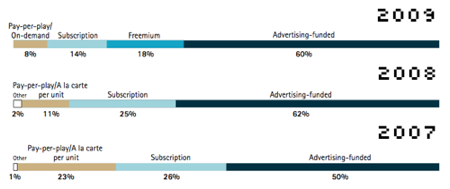What media business model will dominate in the near future? Study says: hybrid
- Transfer

Not only newspapers are now trying to find their place in the digital future. Many media companies - broadcasting, cinema, music, publishing, and gaming - are trying to find a new business model.
In a recent study ( PDF ), Accenture consulting company interviewed 120 leading media companies involved in content production for the biggest challenge they face today. Surprisingly, all the bosses pointed to the search for a viable business model. And since this question (in somewhat conflicting wordings) has been asked for three years already, we can see how the answers have changed.
First, the data directly indicates a clear decline in interest in what Accenture calls pay-per-play. For news, we would call it micropayments (pay per unit of content) or the “iTunes model”. In 2007, 23% of respondents believed that it was micropayments that would grow and in the future would become the main source of media revenue. In 2008, the number of people sharing this point of view fell to 11%. In 2009 there were only 8% of them.
But Accenture changed the answer options, which somewhat blurred the picture. In 2009, two new sources were included in the questionnaire: freemium (part of the content remains free, and the user must pay for the other part) and a hybrid scheme (a combination of different sources of income, for example, advertising and subscription). Anyone can notice that the freemium is a special case of the hybrid scheme, and in the above diagram Accenture combined the " hybrid " answers with the " advertising " ones. (60% in the upper bar actually means 39% advertising + 21% hybrid).
I spoke with David Wolf of Accenture about what conclusions we should draw from these discoveries. He said the most obvious thing is that in the near future, most attention will be paid to hybrid business models. “The only thing that becomes clear from the study is that none of the emerging business models will be the only one ,” Wolf explained.
Hand in hand with the hybrid model, the aggressive transition to a multi-platform content distribution strategy is striding. “What we found out is that platforms and growth need to be considered together,” Wolf explained. “How do we make products that cover all possible types of screens?” About 65% of respondents said that business would grow with new platforms and new delivery methods. 25% said that growth would be due to new content, and only 10% said they were counting on new geographic markets. For three years, these answers have not changed much.

Another trend that the media industry is looking at is the more personalized use of data. Instead of looking at the audience in a general way, Wolf predicts that media companies will learn to adapt to individual consumer needs. About the way hotel chains attract customers through loyalty programs. In those companies where they used to follow the demographic principles of determining the audience in the old fashioned way, Wolf said that they “change the stereotype” to something more individualized.
